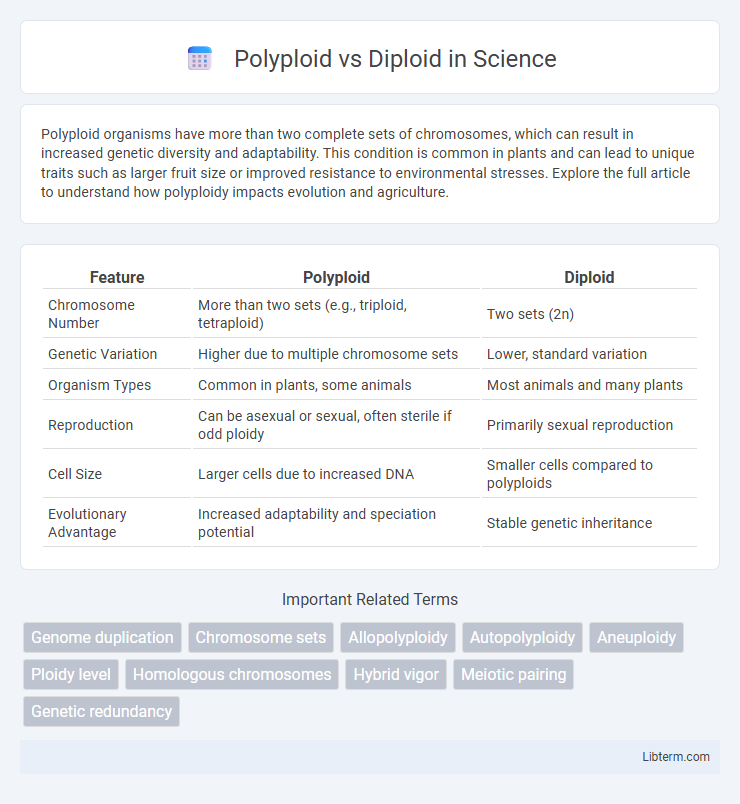Polyploid organisms have more than two complete sets of chromosomes, which can result in increased genetic diversity and adaptability. This condition is common in plants and can lead to unique traits such as larger fruit size or improved resistance to environmental stresses. Explore the full article to understand how polyploidy impacts evolution and agriculture.
Table of Comparison
| Feature | Polyploid | Diploid |
|---|---|---|
| Chromosome Number | More than two sets (e.g., triploid, tetraploid) | Two sets (2n) |
| Genetic Variation | Higher due to multiple chromosome sets | Lower, standard variation |
| Organism Types | Common in plants, some animals | Most animals and many plants |
| Reproduction | Can be asexual or sexual, often sterile if odd ploidy | Primarily sexual reproduction |
| Cell Size | Larger cells due to increased DNA | Smaller cells compared to polyploids |
| Evolutionary Advantage | Increased adaptability and speciation potential | Stable genetic inheritance |
Introduction to Polyploidy and Diploidy
Polyploidy refers to cells or organisms containing more than two complete sets of chromosomes, commonly seen in plants, resulting in increased genetic diversity and adaptability. Diploidy describes the state of having two homologous chromosome sets, one from each parent, which is standard in most animals and many plants for stable inheritance. Understanding the distinctions between polyploid and diploid genomes is crucial for studies in genetics, evolution, and breeding programs.
Defining Diploid and Polyploid Genomes
Diploid genomes contain two complete sets of chromosomes, one inherited from each parent, facilitating genetic stability and diversity through sexual reproduction. Polyploid genomes consist of more than two sets of chromosomes, often arising from whole-genome duplication events, and are common in plants, leading to increased cell size and variation in physiological traits. Understanding the differences between diploid and polyploid genomes is crucial for studying evolution, crop improvement, and genetic adaptation mechanisms.
Origins and Mechanisms of Polyploidy
Polyploidy originates from genome duplication events leading to organisms with multiple sets of chromosomes, contrasting with diploids that possess two sets. Mechanisms of polyploidy include autopolyploidy, which arises from chromosome doubling within a single species, and allopolyploidy, resulting from hybridization between different species followed by chromosome doubling. These processes contribute significantly to plant speciation and genetic diversity by enabling greater genomic variation and adaptation.
Genetic Diversity: Polyploid vs Diploid
Polyploid organisms possess multiple sets of chromosomes, which significantly enhances their genetic diversity compared to diploid organisms that contain only two sets of chromosomes. This increased chromosome number in polyploids allows for greater variation in gene expression and can result in improved adaptability and evolutionary potential. In contrast, diploid organisms have more limited allelic variation, restricting their capacity for genetic diversification and resilience to environmental changes.
Evolutionary Significance of Polyploidy
Polyploidy, the condition of having multiple sets of chromosomes, plays a crucial role in plant evolution by promoting genetic diversity and speciation. Polyploid organisms exhibit increased heterozygosity and gene redundancy, which enhance adaptability and tolerance to environmental stresses. Compared to diploids, polyploids often show greater evolutionary potential due to their ability to undergo rapid genomic changes and exploit new ecological niches.
Physiological and Morphological Differences
Polyploid plants often exhibit increased cell size, leading to larger leaves, flowers, and fruits compared to diploid counterparts, which can enhance their physiological functions such as photosynthesis and water retention. The metabolic rates in polyploids tend to be slower, contributing to greater stress tolerance and improved adaptability in various environmental conditions. Morphologically, polyploids display greater robustness and variability in organ structure, while diploids maintain more uniform characteristics with faster growth rates.
Polyploidy and Speciation
Polyploidy, the condition of having multiple sets of chromosomes beyond the diploid number, plays a crucial role in speciation by creating reproductive barriers that lead to the emergence of new species. This genetic duplication event allows for increased genetic variation and can result in instant speciation, especially common in plants where polyploid individuals are often reproductively isolated from their diploid ancestors. Polyploid speciation contributes significantly to biodiversity and evolutionary adaptation by enabling rapid divergence and the colonization of novel ecological niches.
Agricultural Applications of Polyploid Crops
Polyploid crops exhibit increased genetic material, resulting in enhanced traits such as higher yield, disease resistance, and improved stress tolerance compared to diploid counterparts. Agricultural applications of polyploidy include the development of seedless fruits like watermelons and grapes, as well as larger, more robust cereals such as wheat and cotton. These advantages drive crop improvement programs aimed at boosting productivity and sustainability in diverse environmental conditions.
Challenges Associated with Polyploid and Diploid Breeding
Polyploid breeding faces challenges such as complex genetic inheritance patterns, increased genome size complicating genetic mapping, and difficulties in maintaining stable chromosome numbers during reproduction. Diploid breeding, while genetically simpler, struggles with limited genetic diversity and vulnerability to inbreeding depression, reducing adaptability and crop improvement potential. Both breeding types require tailored strategies to overcome chromosome behavior difficulties and optimize trait selection for agricultural productivity.
Future Perspectives in Polyploidy Research
Advancements in genome sequencing and CRISPR technology are poised to revolutionize polyploidy research, enabling precise genome editing to enhance crop traits and stress resistance. Understanding the gene expression dynamics and epigenetic regulation in polyploids offers promising avenues to improve agricultural productivity and biodiversity conservation. Future studies will likely focus on integrating omics data to unravel complex polyploid genomes, facilitating targeted breeding programs and sustainable crop development.
Polyploid Infographic

 libterm.com
libterm.com